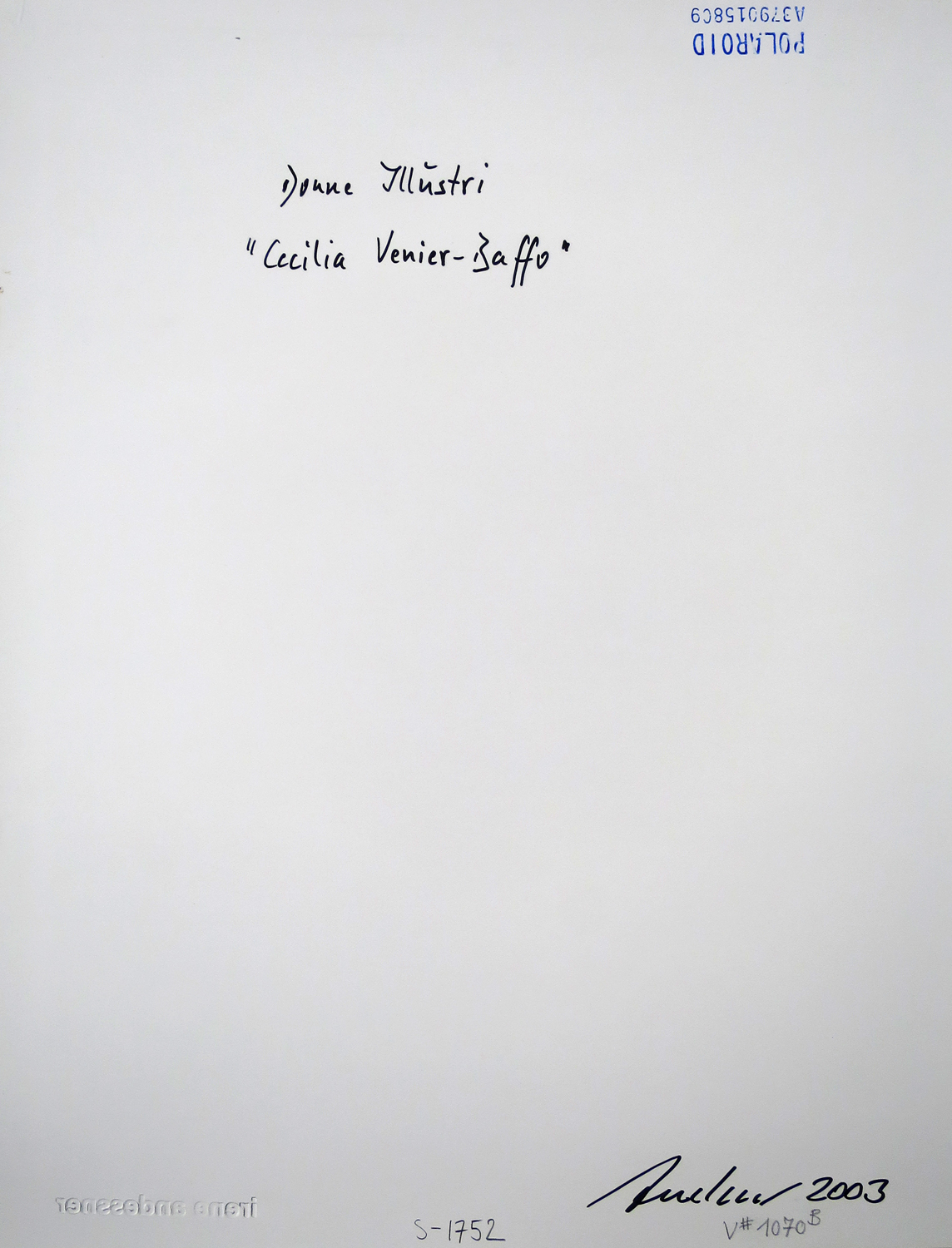"Cecilia Venier-Baffo (1525-1583)"
instant photograph (Polaroid)
signed, titled, dated and numbered (ink) on verso
The Venetian Sultaness
Born the illegitimate daughter of two members of the Venetian aristocracy on the Greek island of Paro, Cecilia Venier-Baffo was kidnapped at the age of twelve by the Barbarossa pirate Hayr-ad-Din Pascià and was given as a gift to the Sultan Suleiman. Renamed Nûr Bânû (Woman of Light), Cecilia was raised in the fortress of the sultan, becoming the favourite of his son, Selim. Recognised as the wife of Selim II and giving birth to his son and successor to the throne, Murad III, Nûr Bânû remained until the end of her days the First Reigning Lady, when her son Murad III reached the age of majority. As the Valid Sultaness (the mother of the Sultan), she worked to institute a pro-Venetian lobby in the Sultan’s palace at the critical moment of Venice’s defeat at Lepanto. Shortly before her death, she managed to stop an attack by the Turkish float on the Venice-dominated island of Crete. The Sultaness cultivated a correspondence with the Doge and with Caterina de’Medici, while her “daughter-in-law” Safje became “pen- friends” with Elizabeth I of England. “He who looks for favour or clemency finds support in the mother or the favourite of the Sultan, and, at the very least, will not displease,” writes the Venetian ambassador Jacopo Saranzo in 1581. The fact that a Venetian noblewoman was able to have such an influence over the Sultan, an absolute despot of the Oriental mould, arouses deep respect and admiration for this woman’s talents in world diplomacy.
Donne Illustri
Caffà Florian on St Mark’s Square in Venice: in the “Sala degli Uomini Illustri” (salon of famous men) hang ten oil paintings by Giulio Carlini (1826–1887). Irene Andessner confronts these posthumously painted portraits of famous Venetians – from Marco Polo via Titian to Goldoni – with ten Venetian women, among them the city’s most famous composer (Barbara Strozzi) and painter (Rosalba Carriera) and the most expensive courtesan (Veronica Franco), as well as the first female doctor (Elena Lucrezia Cornaro Piscopia) and the world’s first female lawyer (Moderata Fonte). Through this intervention the Sala degli Uomini Illustri is transformed into the Sala delle Donne Illustri (salon of famous women). A picture puzzle-like disturbance: disregarding make-up, wardrobe, light, decoration and pictorial detail, Andessner’s portrayals differ from the historical picture references of the ten female figures in that she has not copied the bearing and look of the women, but rather of the men from the portraits hanging above. Thus the self-perception, the pre-potency of the male counterparts is broken.
A further room, the Saletta Liberty, is turned into the “Moderata Fonte Room” with a Fonte/Andessner photographic full-length self-portrait in a light box. Opposite this portrait Andessner places a “Fonte” portrait painted in oil on canvas, for which she sat as model in the workshop of Marinella Biscaro.
“7 Gentildonne”: as a preliminary to the exhibition Andessner convenes a meeting of seven Italians in the Caffà Florian men’s salon – inspired by Moderata Fonte’s debate in the novel “Verdienst der Frauen” [merit of women], documented as a video work. In the photo production for the Venice project there are additional full-length portraits, which transpose into our time the historicised portrayals of women (only visible in oval bust details in the room installation) by means of complete styling. In these images it can also be seen that the artist has the camera shutter release in her hand; which means – in contrast to earlier productions – she releases the image herself in just that moment when she herself inwardly feels the particular role so fully that she is sure she is bringing the personality of that model woman perfectly to expression. This way of working corresponds to the historical Venetian women, who likewise developed and lived out their professions self-determined and self-employed, independent of men. The full-length self-portraits are executed as light boxes.
The “Donne Illustri” project, curated by Stefano Stipitivich, takes place under the auspices of the Art Programme of the Caffà Florian. Started over 15 years ago by the caf» owner and art collector Daniela Gaddo Vedaldi, the series of exhibitions has so far represented artists such as Mimmo Rotella (1990), Fabrizio Plessi (1993 and 2001) and Luca Buvoli (1997)































